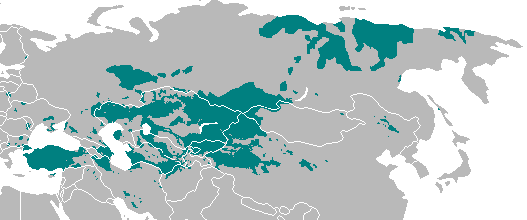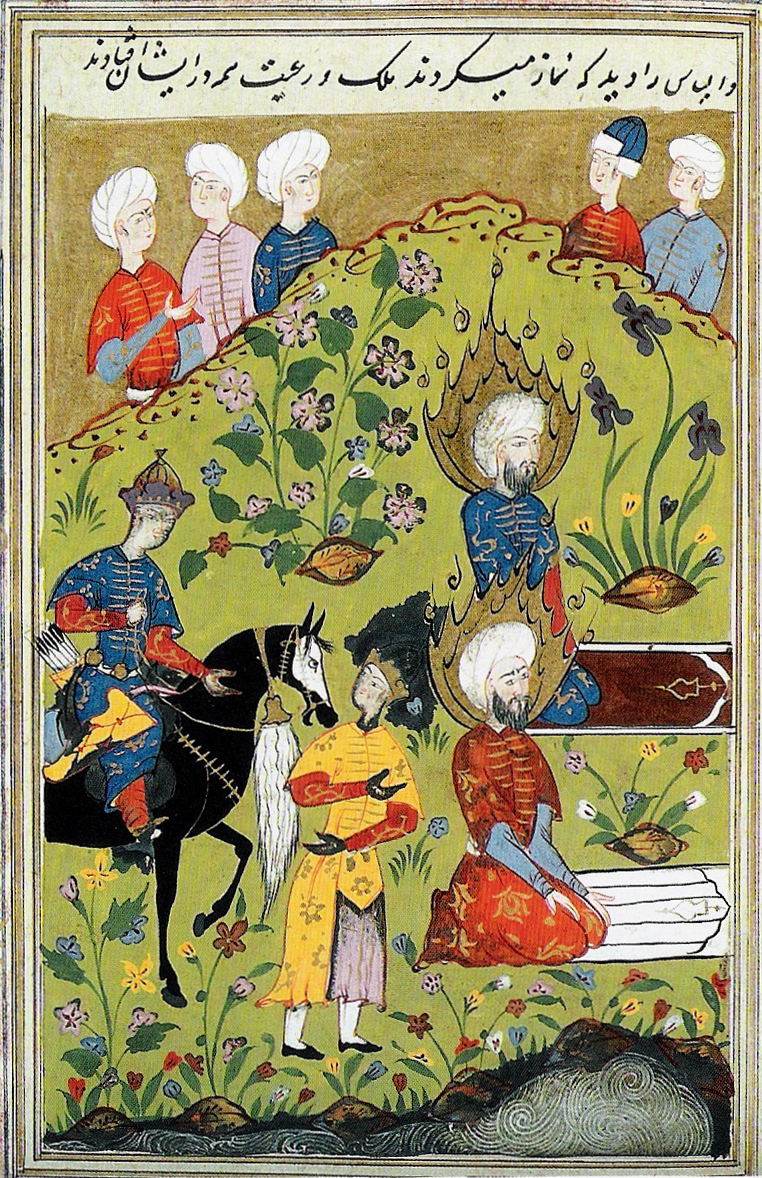|
Zarlik And Munglik (Uzbek Folktale)
Zarlik and Munglik (German: ''Zảrlik und Munglik''; Uzbek: ''Zorlik va Munglik'') is an Uzbek folktale collected by Uzbek folklorist Mansur Afzalov and translated into German by Isidor Levin and Ilse Laude-Cirtautas. It is related to the theme of the calumniated wife and is classified in the international Aarne-Thompson-Uther Index as ATU 707, " The Three Golden Children". Summary A padishah has four wives, but has not fathered any child yet. One day, the youngest wife, named Gulbahra ("Rose-Beautiful") announces she is pregnant. The padishah rejoices in this fact. Gulbahra gives birth to twins, a boy and a girl. The other-cowives, however, see this as a threat to their position and bribe a sorceress named Mastan Kampir to get the children and replace them for puppies. The sorceress takes the children and abandons them in the woods, hoping that the wild animals will devour the twins. Against her expectations, the children are nursed by a wild deer as their foster mother. Years ... [...More Info...] [...Related Items...] OR: [Wikipedia] [Google] [Baidu] |
German Language
German ( ) is a West Germanic languages, West Germanic language mainly spoken in Central Europe. It is the most widely spoken and Official language, official or co-official language in Germany, Austria, Switzerland, Liechtenstein, and the Italy, Italian province of South Tyrol. It is also a co-official language of Luxembourg and German-speaking Community of Belgium, Belgium, as well as a national language in Namibia. Outside Germany, it is also spoken by German communities in France (Bas-Rhin), Czech Republic (North Bohemia), Poland (Upper Silesia), Slovakia (Bratislava Region), and Hungary (Sopron). German is most similar to other languages within the West Germanic language branch, including Afrikaans, Dutch language, Dutch, English language, English, the Frisian languages, Low German, Luxembourgish, Scots language, Scots, and Yiddish. It also contains close similarities in vocabulary to some languages in the North Germanic languages, North Germanic group, such as Danish lan ... [...More Info...] [...Related Items...] OR: [Wikipedia] [Google] [Baidu] |
Turkish Studies
Turkology (or Turcology or Turkic studies) is a complex of humanities sciences studying languages, history, literature, folklore, culture, and ethnology of people speaking Turkic languages and Turkic peoples in chronological and comparative context. This includes ethnic groups from the Sakha in East Siberia to the Balkan Turks and the Gagauz in Moldova. History Ethnological information on Turkic tribes for the first time was systemized by the 11th-century Turkic philologist Mahmud al-Kashgari in the ''Dīwān ul-Lughat it-Turk'' (Dictionary of Turkic language). Multi-lingual dictionaries were compiled from the late 13th century for the practical application of participants in international trade and political life. One notable such dictionary is the ''Codex Cumanicus'', which contains information for Cuman, Persian, Latin, and German. There are also bilingual dictionaries for Kipchak and Armenian as well as Kipchak and Russuan. In the Middle Ages, Turkology was centred around ... [...More Info...] [...Related Items...] OR: [Wikipedia] [Google] [Baidu] |
Grigory Potanin
Grigory Nikolayevich Potanin (alt. Grigorij Potanin) (russian: Григорий Николаевич Потанин; 4 October 1835 – 6 June 1920) was a Russian ethnographer and natural historian. He was an explorer of Inner Asia, and was the first to catalogue many of the area's native plants. On home soil, Potanin was an author and a political activist who aligned himself with the Siberian independence movement. Life Early life Potanin attended a Page Corps in Omsk, a military school for children from wealthy families. Potanin initially travelled to Siberia while serving with a Cossack division in Altaj in the 1850s. He returned to Saint Petersburg in 1858 to study Mathematical Physics. He was arrested for his participation in student demonstrations in 1861, and expelled from Saint Petersburg University. After spending three months in Petropavlovskaya fortress, he returned to Siberia. After leaving prison, he travelled to Siberia with Nikolai M. Yadrintsev, whe ... [...More Info...] [...Related Items...] OR: [Wikipedia] [Google] [Baidu] |
Tulpar
Tulpar / ; ba, Толпар, ; tt-Cyrl, Тулпар, ; ky, Тулпар; tr, Tulpar; uz, Tulpor / ; ug, تۇلپار is a winged or swift horse in Turkic mythology (for example, Kazakh and Tatar mythology), similar to Pegasus. Tulpar is also in state emblems of Kazakhstan and Bashkortostan. Tulpar came to be due to the hunting lifestyle of the people of Central Asia. The people hunted with horses, with the company of a bird of prey. These two animals, with the human imagination, formed into one creating the winged horse known as Tulpar. This mythical creature has also been used as state symbols of Kazakhstan, the emblem of which is decorated with two golden Tulpars, the top of a yurt (the yurt is a traditional tent where the Kazakhs lived) and the sun rays. The blue background represents the sky where the Tulpars run. Tulpar is the legendary horse that appears in culture of Turkic-speaking nations (Turks, Uzbeks, Kazakhs, Kyrgyz, etc.). The association of a bird w ... [...More Info...] [...Related Items...] OR: [Wikipedia] [Google] [Baidu] |
Zhalmauyz Kempir
Zhalmauyz Kempir ( kk, Жалмауыз Кемпір) is a female personage of Kazakh folk tales, a witch. According to Nora K. Chadwick and Viktor Zhirmunsky, the character appears in the non-epic traditions of the Turkic peoples under several names, e.g., ''Jelmogus'', ''Dshalmaus'' and ''Jel Maja''. In Kazakh folklore Kazakh oral tradition describes Zhalmauyz Kempir as an old ugly hag often with some grotesque features such as seven heads, sharp claws, one eye, hooves. She possesses supernatural strength, magic power, superspeed, etc. Zhalmauyz Kempir is described as a witch with magic power who can change her shape at will. She is also said to be a cannibal or to suck blood like a vampire. Unlike other witches of Kazakh folklore, such as Albasty and Zheztyrnaq, Zhalmauyz Kempir has an ambiguous role, not only of the absolute evil, but also of a kind helper, because in some cases she can be helpful to character in a fairy tale. However, in her usual depiction she acts like ... [...More Info...] [...Related Items...] OR: [Wikipedia] [Google] [Baidu] |
Dombra
The ''dombra'', also known as ''dombyra'' ( kz, домбыра, uz, dombira, ba, думбыра) is a long-necked Kazakh, Uzbek and Bashkir lute and a musical string instrument. The dombyra shares certain characteristics with the komuz and dutar, such as its long, thin neck and oblong body shape. It is a popular instrument mostly among Turkic communities in Central Asian countries such as Kazakhstan, Uzbekistan, Tajikistan, Turkmenistan and Afghanistan. Varieties The instrument differs slightly in different regions. The Kazakh dombyra has frets and is played by strumming with the hand or plucking each string individually, with an occasional tap on the main surface of the instrument. While the strings are traditionally made of sinew, modern dombras are usually produced using nylon strings. One of the greatest dombra players was the Kazakh folk musician and composer Kurmangazy Sagyrbayuly, who had a major influence on the development of Kazakh musical culture, including ... [...More Info...] [...Related Items...] OR: [Wikipedia] [Google] [Baidu] |
Khidr
Al-Khidr () ( ar, ٱلْخَضِر, al-Khaḍir), also transcribed as al-Khadir, Khader, Khidr, Khizr, Khazer, Khadr, Khedher, Khizir, Khizar, is a figure described but not mentioned by name in the Quran as a righteous servant of God possessing great wisdom or mystic knowledge. In various Islamic and non-Islamic traditions, Khidr is described as a messenger, prophet or wali, who guards the sea, teaches secret knowledge and aids those in distress. He prominently figures as patron of the Islamic saint ibn Arabi. The figure of al-Khidr has been syncretized over time with various other figures including Dūraoša and Sorūsh in Iran, Sargis the General and Saint George in Asia Minor and the Levant, Samael (the divine prosecutor) in Judaism, Elijah among the Druze, John the Baptist in Armenia, and Jhulelal in Sindh and Punjab in South Asia. Though not mentioned by name in the Quran, he is named by Islamic scholars as the figure described in as a servant of God who has been given ... [...More Info...] [...Related Items...] OR: [Wikipedia] [Google] [Baidu] |
Kazakhstan
Kazakhstan, officially the Republic of Kazakhstan, is a transcontinental country located mainly in Central Asia and partly in Eastern Europe. It borders Russia to the north and west, China to the east, Kyrgyzstan to the southeast, Uzbekistan to the south, and Turkmenistan to the southwest, with a coastline along the Caspian Sea. Its capital is Astana, known as Nur-Sultan from 2019 to 2022. Almaty, Kazakhstan's largest city, was the country's capital until 1997. Kazakhstan is the world's largest landlocked country, the largest and northernmost Muslim-majority country by land area, and the ninth-largest country in the world. It has a population of 19 million people, and one of the lowest population densities in the world, at fewer than 6 people per square kilometre (15 people per square mile). The country dominates Central Asia economically and politically, generating 60 percent of the region's GDP, primarily through its oil and gas industry; it also has vast mineral ... [...More Info...] [...Related Items...] OR: [Wikipedia] [Google] [Baidu] |
Kasymbek Yeshmambetov
Kasymbek Yeshmambetov ( ky, Эшмамбетов Касымбек; 2 October 1910 – 10 February 1984) was a Kyrgyz writer, playwright, translator, and a member of the Union of Soviet Writers. Early life He was born in Orto-Say to a peasant family. Until 1920, he studied at the agriculture school. He graduated from the Pedagogical College in Feunze in 1930. Career He taught medicine, economics and construction during his time at the college. In 1930, he published his first story, "The Mystery of Nature," and seven years later, he wrote the play ''Saryndzhi''. He translated various works of William Shakespeare, Alexander Ostrovsky, Pushkin, Fyodor Dostoevsky, Leo Tolstoy and others in Kyrgyz. He published books in Russian, including ''Pieces'' (1958), ''Four of the most daring'' (1958), ''Hunter with a golden eagle'' (1960) and ''The Dream'' (1964). Recognition He won the award for Literature and Art in the Great Patriotic War The Eastern Front of World War I ... [...More Info...] [...Related Items...] OR: [Wikipedia] [Google] [Baidu] |
Hungarian Language
Hungarian () is an Uralic language spoken in Hungary and parts of several neighbouring countries. It is the official language of Hungary and one of the 24 official languages of the European Union. Outside Hungary, it is also spoken by Hungarian communities in southern Slovakia, western Ukraine ( Subcarpathia), central and western Romania (Transylvania), northern Serbia (Vojvodina), northern Croatia, northeastern Slovenia (Prekmurje), and eastern Austria. It is also spoken by Hungarian diaspora communities worldwide, especially in North America (particularly the United States and Canada) and Israel. With 17 million speakers, it is the Uralic family's largest member by number of speakers. Classification Hungarian is a member of the Uralic language family. Linguistic connections between Hungarian and other Uralic languages were noticed in the 1670s, and the family itself (then called Finno-Ugric) was established in 1717. Hungarian has traditionally been assigned to the Ugric alo ... [...More Info...] [...Related Items...] OR: [Wikipedia] [Google] [Baidu] |
Kyrgyzstan
Kyrgyzstan,, pronounced or the Kyrgyz Republic, is a landlocked country in Central Asia. Kyrgyzstan is bordered by Kazakhstan to the north, Uzbekistan to the west, Tajikistan to the south, and the People's Republic of China to the east. Its capital and largest city is Bishkek. Ethnic Kyrgyz make up the majority of the country's seven million people, followed by significant minorities of Uzbeks and Russians. The Kyrgyz language is closely related to other Turkic languages. Kyrgyzstan's history spans a variety of cultures and empires. Although geographically isolated by its highly mountainous terrain, Kyrgyzstan has been at the crossroads of several great civilizations as part of the Silk Road along with other commercial routes. Inhabited by a succession of tribes and clans, Kyrgyzstan has periodically fallen under larger domination. Turkic nomads, who trace their ancestry to many Turkic states. It was first established as the Yenisei Kyrgyz Khaganate later in the ... [...More Info...] [...Related Items...] OR: [Wikipedia] [Google] [Baidu] |




